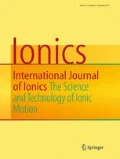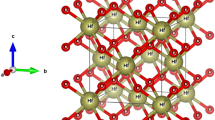Abstract
In materials that are of interest for use as solid electrolytes it is important that charge transport is predominantly related to ionic motion, with minimal minority electronic conduction. On the other hand, a number of materials are mixed ionic and electronic conductors.
Several DC methods that have been developed over many years to evaluate the separate electronic and ionic components of the total charge transport in solids. These include the Tubandt DC method, the DC assymetric polarization technique sometimes called the Hebb-Wagner method, and the DC open circuit potential method.
This paper presents a new method that is relatively simple, and could be advantageous in some cases. It involves the employment and proper interpretation of low amplitude variable frequency AC measurements, a general technique that is often called impedance spectroscopy. As an example, the results of the use of this method on a mixed-conducting perovskite related to the well-known LSGM, La0.4Pr0.4Sr0.2In0.8Mg0.2O2.8, are shown.
Similar content being viewed by others
15. References
W. Hittorf, Ann. Physik106, 543 (1859).
C. Tubandt, Z. Electrochem.26, 338 (1920).
C. Wagner, in: 7th Meeting of the International Committee of Electrochemical Thermodynamics and Kinetics, Butterworths, London, 1956.
R.A. Huggins, Solid State Ionics143, 3 (2001).
J.W. Patterson, E.A. Bogren, and R.A. Rapp, J. Electrochem. Soc.114, 752 (1967).
B. Ilschner, J. Chem. Phys.28, 1109 (1958).
S. Crouch-Baker, Solid State Ionics45, 101 (1991).
V.B. Tare and H. Schmalzried, Z. physik. Chem. NF43, 30 (1964).
C. Wagner, Adv. in Electrochem. and Electrochem. Eng.4, 1 (1966).
R.A. Huggins, Ionics5, 269 (1999).
D.O. Raleigh, Electroanal. Chem.6, 87 (1972).
B.E. Conway, J. Electrochem. Soc.138, 1539 (1991).
I.D. Raistrick, C. Ho, and R.A. Huggins, J. Electrochem. Soc.123, 1469 (1976).
C. Ho, I.D. Raistrick, and R.A. Huggins, J. Electrochem. Soc.127, 343 (1980).
I.D. Raistrick, C. Ho, Y.W. Hu, and R.A. Huggins, J. Electroanal. Chem.77, 319 (1977).
Author information
Authors and Affiliations
Rights and permissions
About this article
Cite this article
Huggins, R.A. Simple method to determine electronic and ionic components of the conductivity in mixed conductors a review. Ionics 8, 300–313 (2002). https://doi.org/10.1007/BF02376083
Received:
Accepted:
Issue Date:
DOI: https://doi.org/10.1007/BF02376083




